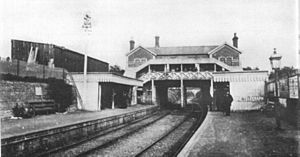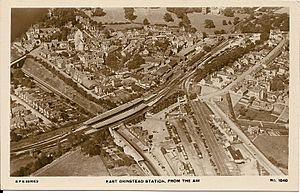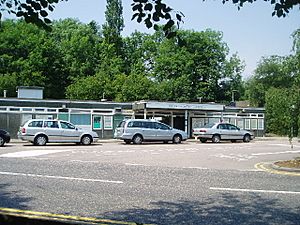East Grinstead railway station facts for kids
Quick facts for kids
|
|
|---|---|
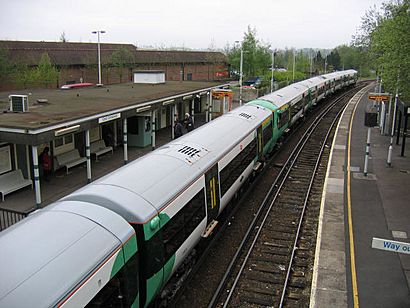 |
|
| Location | East Grinstead, District of Mid Sussex England |
| Coordinates | 51°07′34″N 0°01′05″W / 51.126°N 0.018°W |
| Platforms | 2 |
| Other information | |
| Station code | EGR |
| Classification | DfT category C1 |
| Key dates | |
| 1 August 1882 | Present station opened as East Grinstead Low Level |
| 1970 | Renamed East Grinstead and station rebuilt |
| 2013 | Station rebuilt again and Bluebell Railway restores connection to station |
| Traffic | |
| Passengers (2015/16) | |
| Passengers (2016/17) | |
| Passengers (2017/18) | |
| Passengers (2018/19) | |
| Passengers (2019/20) | |
East Grinstead railway station is a train station in East Grinstead, West Sussex, England. It's one of the two main stops at the end of the Oxted line. The station is about 30 miles 4 chains (48.36 km) from London Bridge. However, most trains go to and from London Victoria. Southern manages the station.
In the past, the station had two levels. The higher level served trains on the Three Bridges to Tunbridge Wells Central Line. The lower level handled trains from the Oxted line and the East Grinstead to Lewes Line.
Today, only the lower-level platforms are open. The high-level section closed in 1967. This happened as part of big railway changes called the Beeching Report. A third low-level platform was built by the Bluebell Railway. Since 2013, Bluebell services have run south from here to Sheffield Park.
Contents
East Grinstead's Train Stations: A Journey Through Time
The current East Grinstead station is the fourth one built in the town. Before trains arrived, the closest stations were 6 miles (9.7 km) away. These were at Godstone and Three Bridges.
Early Stations
The First Station (1855)
The very first station in East Grinstead opened on 9 July 1855. It was the end of a single-track line from Three Bridges. The station was built in Swan Mead, close to the town centre. It cost about £3,000 to build.
The station had a main building made of sandstone, which is still there today. It also had timber sheds for goods and engines. The first train left at 12:12 pm. The first stationmaster was Peter Nesbitt.
At first, there were six trains each way daily, and two on Sundays. People used the Sunday trains so much that a local church leader, Reverend Woodington, would visit the station. He would hand out religious papers, asking passengers to "listen to the church bells instead of the railway bells."
The trip to Three Bridges took 20 minutes. The train fare to London was 6 shillings for first class and 3 shillings for third class. The London, Brighton and South Coast Railway operated the line. They bought the East Grinstead Railway in 1865.
The Second Station (1866)
In 1862, plans were approved to extend the line to Tunbridge Wells West. This meant the East Grinstead station had to move a few yards north. It was built at a lower level in a cutting. This allowed the line to pass under London Road. You reached the station by steps from the road.
The new station building was built over the double tracks. It had basements at platform level for offices. A large brick goods shed replaced the old timber one. The site of the old station became a goods yard. The new station opened on 1 October 1866, and the old one closed that same day.
The 1882 Rebuilding
A third big change to East Grinstead station was needed. This was because two new lines were arriving in town. The Lewes and East Grinstead Railway (L&EG) came from the south in 1882. The Croydon, Oxted and East Grinstead Railway (CO&EG) came from the north in 1884.
It was not possible to make the 1866 station bigger. So, they decided to build a brand new station about 300 yards (270 m) to the west. This new station would have two levels. The main buildings were on the low-level platform.
The low-level station was built at a right angle to the high level. It had two platforms for the L&EG and CO&EG lines. The new station was still being built when the L&EG opened in 1882. So, trains used the 1866 station until 15 October 1883. On that day, both the new high and low-level stations opened. The 1866 station then closed and was later taken down.
The new line to London was 6 miles (9.7 kilometres) shorter than the old route. The main station building was designed in a special style. It had refreshment rooms on both levels. The one on the low level was even said to have a billiards room for travelers! An 1885 book described the station as "very convenient" and "a pleasing object."
The station had north and south signal boxes. These controlled the train movements. The south box was used until 1987. It has since been removed.
The 1970 Rebuilding
From 1955, the low-level station was barely used. Most passengers used the high-level station. The L&EG line closed in 1958. After the Three Bridges-Ashurst Junction line closed in 1967, all London trains used the low level.
The 1882 station building was taken down starting in 1970. A new, smaller building opened in 1972. This new building was simpler, reflecting that the station was now the end of a branch line from Oxted. Some parts of the old station, like cast-iron pillars and gas lamps, were sold to a restaurant owner in California.
A concrete footbridge was built in 1970 to connect the two platforms. This was needed because the high-level station, which provided access, was gone. The Oxted line was electrified between 1986 and 1987. The platforms were also made longer for eight-car trains.
The 2013 Rebuilding
By 2012, a new station building was built next to the existing one. It cost £2.1 million. The old building was taken down in 2013. The new project also included new waiting shelters, bike storage, and a bigger car park. The car park capacity increased from 236 to 336 spaces.
The old station was considered too old and needed to be replaced. The new station opened on 17 December 2012. The official opening was on 8 March 2013.
Station Facilities
The station has a ticket office and ticket machine. There's also a small shop, toilets, a car park, and a taxi stand. You can also store your bicycle here.
Train Services
Today's Services
Usually, trains run every half hour to London Victoria. This includes Sundays. The journey takes about an hour. Trains stop at all stations up to Sanderstead, then East Croydon and Clapham Junction.
During busy times, there are extra trains. Some go to London Bridge. These trains also stop at South Croydon, then East Croydon, and then run straight to London Bridge.
At peak times, some direct trains go to Bedford via London Bridge. These are run by Thameslink.
| Preceding station | Following station | |||
|---|---|---|---|---|
| Dormans | Southern Oxted Line East Grinstead branch |
Terminus | ||
| Terminus | Thameslink Bedford - East Grinstead Peak hours only |
Terminus | ||
| Terminus | Bluebell Railway | Kingscote | ||
| Historical railways | ||||
| Dormans Line and station open |
London, Brighton and South Coast Railway Lewes and East Grinstead Railway |
Kingscote Line and station open |
||
| Disused railways | ||||
| Grange Road Line and station closed |
British Rail Southern Region Three Bridges to Tunbridge Wells Central Line |
Forest Row Line and station closed |
||
Bus Services
East Grinstead Station has a bus station nearby. The following bus services stop here:
- Southdown Buses Route 236 to Lingfield, Edenbridge and Oxted.
- Compass Bus Route 261 to Forest Row and Uckfield.
- Metrobus Route 270 to Haywards Heath, Burgess Hill and Brighton.
- Metrobus Route 281 to Dormansland and Lingfield, and Crawley in the other direction.
- Metrobus Route 291 to Tunbridge Wells, and Crawley in the other direction.
- Metrobus Route 400 to Crawley, Redhill and Caterham.
- Southdown Buses Route 409 to Lingfield, Caterham and Selsdon.
Past Services
East Grinstead has mostly had local train services. These went to London, Brighton, Three Bridges, and Tunbridge Wells. In the early days, there were about five or six trains a day on weekdays. The number of trains grew as more people started commuting in the 1890s.
During World War II, train services were cut back a lot due to fuel shortages. By 1952, services still hadn't returned to how they were before the war.
In 1955, the Oxted line schedule was changed. Trains ran hourly outside of busy times. This helped East Grinstead's population grow by 40% between 1951 and 1961.
Train Types Used
Small steam engines were used until the 1870s. Later, more powerful engines were introduced. After World War I, even heavier engines were used.
In the 1950s, some new types of steam engines were tested. In the last days of steam trains, different types of steam engines were used. Diesel trains started running in the early 1960s. The Oxted line was electrified in 1987. Electric trains began running on 5 October 1987.
The Bluebell Railway
Buying the Land
|
East Grinstead
|
|
|---|---|
| Station on heritage railway | |
| Location | East Grinstead, District of Mid Sussex England |
| Operated by | Bluebell Railway |
| Platforms | 1 |
| Key dates | |
| 4 September 2010 | Public opening |
| 23 March 2013 | Opening of line to Kingscote |
The Bluebell Railway is a heritage railway. It reopened part of the old L&EG line from Sheffield Park in 1960. They slowly extended the line north. In 1991, British Rail agreed to sell land for a new station at East Grinstead to the Bluebell Railway for just £1.00. This land was south of the existing station.
Even with this agreement, other companies tried to buy the land. For example, Sainsbury's wanted to build a supermarket and car park there. But the local council and railway authorities refused these plans. In 2006, Network Rail finally sold the station site to the Bluebell Railway.
Building the Station
Work to clear the site for a new platform began in May 2008. In January 2009, Network Rail connected the Bluebell Railway's track to the main line.
To celebrate, a special train unit, no. 3417, was moved to the station site. It was the first train to use the new connection.
By July 2009, services and facilities were being installed. Tracklaying in the station area was finished by June 2010. Then, trains started carrying away waste from the nearby Imberhorne Cutting. This cutting had been used as a landfill for about 25 years. Over 90,000 tons of rubbish were removed by December 2011.
The station's design is simple. It allows trains from the south to arrive directly at the platform. This lets the engine detach and move to the other end of the train. Trains in the station area must go slowly, at 10 miles per hour (16 km/h), to reduce noise and smoke.
Opening Day
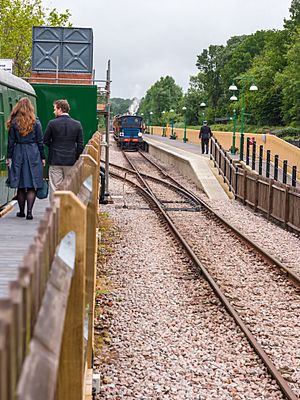
The Bluebell Railway station first opened to the public on 4 September 2010. A special train broke through a ceremonial banner. The first direct train service to the end of the line ran on 6 November 2010.
The Bluebell Railway began regular services to East Grinstead on 23 March 2013. The first train was "The Pioneer" to Sheffield Park. It was pulled by a steam engine called LB&SCR A1X class 55 Stepney. The first through service from London Victoria since 1963 ran on 28 March 2013.
After the extension opened, the Bluebell Railway's passenger numbers greatly increased. They rose from 60,000 to 250,000 in one year!
High Level Station
Opening and Design
|
East Grinstead High Level
|
|
|---|---|
| Location | East Grinstead, District of Mid Sussex England |
| Platforms | 4 |
| Other information | |
| Status | Disused |
| History | |
| Pre-grouping | London, Brighton and South Coast Railway |
| Post-grouping | Southern Railway Southern Region of British Railways |
| Key dates | |
| 1 August 1882 | Opened |
| 2 January 1967 | Closed to passengers |
| 10 April 1967 | Closed to goods |
The high-level station opened on 1 August 1882. It was still being built at the time. It had two island platforms, numbered 3 and 4. These platforms served four tracks on the Three Bridges line. Below it was the low-level station.
The high-level station had refreshment rooms on each platform. It also had two signal cabins. The platforms were made of timber where they crossed over the low-level tracks. The platforms were connected by staircases.
In 1884, a sharply curving spur line, called "St. Margaret's Loop," opened. This connected the high-level station to the CO&EG line.
Closure of the High Level Station
The Three Bridges-Ashurst Junction line closed on 1 January 1967. This meant the end for the high-level station and St Margaret's Loop. They would no longer receive trains. The goods yard also closed.
The last train to use the station was in February 1968. It was a train removing tracks. Passengers used the high-level station as a shortcut between platforms. This was because the footbridge at the low-level platforms had been removed.
The high-level station was taken down in 1970. This led to protests from passengers who lost their shortcut. As a result, British Rail built a new footbridge. This footbridge is still there today.
The area where the goods yard was is now part of the A22 road. The site of the high-level station is now a car park. Beyond the car park, the old railway embankment was removed for a new road, the A22 Beeching Way. In 1979, much of the old trackbed from Three Bridges to East Grinstead became a footpath and cycleway called the Worth Way.
Future Plans
Some people have suggested reopening the line from Tunbridge Wells to Three Bridges. This could help with traffic on the A264 road. However, there are many challenges:
- An industrial site and a recycling centre are now where Forest Row railway station used to be.
- About 1 mile (1.6 km) of the old trackbed in East Grinstead is now part of a relief road, the A22 Beeching Way. This road would need to be changed back into a railway. This would likely cause more traffic problems.
- The site of Grange Road is now covered by shops and houses.
- Parts of the old railway line are now walking and cycling paths. These include the Forest Way and the Worth Way. They are part of Sustrans' National Cycle Route 1.
Images for kids
-
A Bluebell Railway heritage train arrives into the Bluebell's East Grinstead station platform, during the railway's 2013 Edwardian weekend. The two people on the left are walking along the heritage line's Observation platform. To the right, beyond the second fence where the guard is, is located the connecting line to Network Rail



